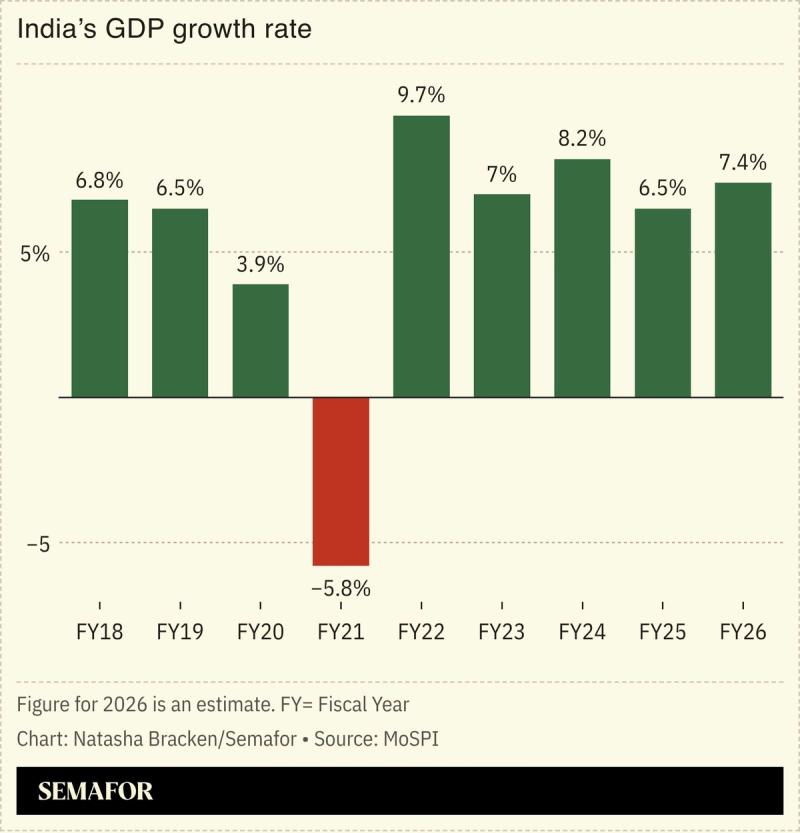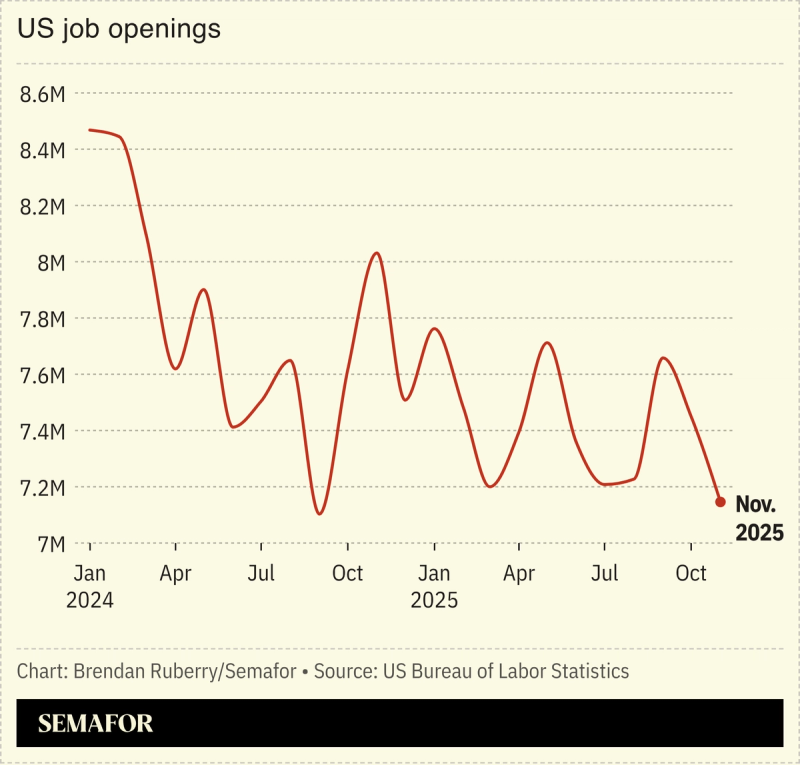More from Semafor Flagship
Late bloomers often outperform youth prodigies, research suggested.
A study of 34,000 high achievers found that, across various disciplines, those who achieved elite performance early on were not always the same people who reached pinnacles in adulthood. The researchers suggested that the prodigies specialized in a single discipline — “a pianist plays no other instrument; a swimmer stays off the running track,” in The New York Times’ words — while later bloomers dabbled in multiple fields.
The study has limitations: It’s impossible to randomize children to different careers. And being a clever child probably still portends being a successful adult. A 2023 study found that “gifted” youths tend to earn more and have more successful careers than the average.
Young people will be better equipped than older workers to adjust to AI’s disruptive economic effects, new research from two major investment banks suggested.
Workers under 30 can switch career paths more easily, Goldman Sachs analysts said in a note to clients, and learn the new skills required for AI-enabled work, while older workers may face the highest earnings loss.
Older people are also more likely to hold significant equity, a separate report from HSBC’s global chief economist said, so their wealth will be hit hardest if or when a feared bubble in AI investment pops.
Nonetheless, recent studies say that there are fewer entry-level roles being posted, which some firms credit to AI reducing headcount requirements.
Beijing is reportedly set to approve imports of Nvidia chips, in what would be a significant win for the US chip giant.
The US has long sought to curtail China’s access to cutting-edge semiconductors, but the Trump administration last year allowed Nvidia to sell its older-generation H200 AI chips. Beijing plans to allow limited imports, Bloomberg reported, though none for use in military or other sensitive sectors.
Nvidia expects huge demand: “We’ve fired up our supply chain,” its CEO said this week.
The decision is unlikely to blunt Chinese ambitions to grow their domestic chip sector, though, with the head of the country’s main semiconductor trade body warning that the industry must “remain highly vigilant” against dependence on the US.
Glencore and Rio Tinto revived merger talks that would create the world’s largest mining company, as global demand surges for metals and minerals key to the energy transition and AI infrastructure buildout.
Negotiations between the pair collapsed in 2024, but have taken on renewed momentum after a recent deal combining Anglo American and Canada’s Teck Resources, the Financial Times noted, putting pressure on other mining giants to scale up to better access crucial minerals.
Copper prices in particular have surged to record highs in recent weeks as analysts warn of a looming supply shortfall: Copper is a necessary component for the huge wave of electrification being planned across much of the world.

Sudan’s civil war has devastated the country’s cultural heritage, effectively wiping out centuries of valuable relics.
The conflict has left around 10 million people displaced and an estimated 150,000 killed.
The paramilitary Rapid Support Forces’ two-year occupation of Khartoum has also seen 4,000 items looted from the Sudan National Museum, including mummies dating from 2,500 BC. Museums and ancient palaces in Darfur and El Geneina were destroyed or emptied.
Officials say truckloads of antiquities were driven from the capital in 2023 — RSF members filmed themselves opening crates of mummified remains — and estimate total losses at $110 million. “They tried to erase our history,” one official told Le Monde.
Saudi Arabia accused the UAE of aiding a Yemeni separatist, ramping up tensions between the Gulf powers, which are on opposing sides of multiple conflicts.
The two are close allies of the US, yet are increasingly competing across technology, energy, and geopolitics: Riyadh and Abu Dhabi back rival factions in Sudan, and have taken differing positions over Israel’s surprise recognition of Somaliland.
Their coalition to repel Iran-backed fighters in Yemen is also fracturing as the UAE has allegedly increased support to a group that Saudi opposes. Online, Emirati and Saudi commentators are locked in a worsening war of words. The row, one Middle East expert warned, was “about more than just Yemen” and in fact pointed to a “regional transformation.”
The World
at a Glance
Updated 8:06am PST

The EU provisionally approved a trade deal with the South American Mercosur bloc to create the world’s largest free trade zone after 25 years of negotiations marked by deep divisions within the EU’s member states.
A “cars for cows” agreement favoring EU industrial goods and LatAm farm products, Mercosur’s champions argued the deal secures EU access to Brazil and Argentina’s critical minerals, reducing dependence on China and proving Europe can overcome disagreements to act decisively.
The agreement, set to be signed next week, overcomes intense opposition from European farmers, and demonstrates that Europe’s efforts to extend economic collaboration stand in stark contrast to the US’ approach of “coercion over cooperation,” The New York Times wrote.
The US economy added 50,000 jobs in December, falling short of expectations and capping off the weakest year of job growth since the pandemic.
Hiring has been sluggish through 2025, which economists attributed to uncertainty around trade and obstinate inflation, as well as the concerns around AI’s impact on the labor market — factors that prompted the US Federal Reserve to cut interest rates three consecutive times late in the year.
According to Friday’s data released by the Labor Department, the unemployment rate, however, dipped to 4.4% in December after creeping higher for several months, bolstering expectations that the central bank would hold rates steady this month.
Beijing is reportedly set to approve imports of Nvidia chips, in what would be a significant win for the US chip giant.
The US has long sought to curtail China’s access to cutting-edge semiconductors, but the Trump administration last year allowed Nvidia to sell its older-generation H200 AI chips. Beijing plans to allow limited imports, Bloomberg reported, though none for use in military or other sensitive sectors.
Nvidia expects huge demand: “We’ve fired up our supply chain,” its CEO said this week.
The decision is unlikely to blunt Chinese ambitions to grow their domestic chip sector, though, with the head of the country’s main semiconductor trade body warning that the industry must “remain highly vigilant” against dependence on the US.
Glencore and Rio Tinto revived merger talks that would create the world’s largest mining company, as global demand surges for metals and minerals key to the energy transition and AI infrastructure buildout.
Negotiations between the pair collapsed in 2024, but have taken on renewed momentum after a recent deal combining Anglo American and Canada’s Teck Resources, the Financial Times noted, putting pressure on other mining giants to scale up to better access crucial minerals.
Copper prices in particular have surged to record highs in recent weeks as analysts warn of a looming supply shortfall: Copper is a necessary component for the huge wave of electrification being planned across much of the world.

Sudan’s civil war has devastated the country’s cultural heritage, effectively wiping out centuries of valuable relics.
The conflict has left around 10 million people displaced and an estimated 150,000 killed.
The paramilitary Rapid Support Forces’ two-year occupation of Khartoum has also seen 4,000 items looted from the Sudan National Museum, including mummies dating from 2,500 BC. Museums and ancient palaces in Darfur and El Geneina were destroyed or emptied.
Officials say truckloads of antiquities were driven from the capital in 2023 — RSF members filmed themselves opening crates of mummified remains — and estimate total losses at $110 million. “They tried to erase our history,” one official told Le Monde.
Saudi Arabia accused the UAE of aiding a Yemeni separatist, ramping up tensions between the Gulf powers, which are on opposing sides of multiple conflicts.
The two are close allies of the US, yet are increasingly competing across technology, energy, and geopolitics: Riyadh and Abu Dhabi back rival factions in Sudan, and have taken differing positions over Israel’s surprise recognition of Somaliland.
Their coalition to repel Iran-backed fighters in Yemen is also fracturing as the UAE has allegedly increased support to a group that Saudi opposes. Online, Emirati and Saudi commentators are locked in a worsening war of words. The row, one Middle East expert warned, was “about more than just Yemen” and in fact pointed to a “regional transformation.”
US President Donald Trump will today aim to convince top energy executives to increase investment in Venezuela’s oil industry as he fights off opposition in Washington over his use of the military in the country.
The White House talks with representatives of companies, including Chevron and Exxon Mobil, are part of wide-ranging US efforts to expand control over crude production in Venezuela. It is a tough sell: Venezuela has the world’s largest stated oil reserves, but increasing output is rife with challenges.
Trump credited Caracas’ cooperation over oil for warding off further attacks, but he also faces growing domestic criticism, including from Republicans: Five GOP senators sided with Democrats to advance a resolution curbing Trump’s use of the military there.

The US is reportedly considering paying Greenlanders up to $100,000 each as part of efforts to annex the Danish territory.
Washington has stepped up its rhetoric about taking over the island, potentially by force: President Donald Trump has said that Washington “needs” Greenland for its mineral wealth and strategic importance, and the US federal government may invest in mining operations there.
European nations have rejected any takeover, but the US secretary of state will meet Danish officials next week, and Trump “has shown no sign of changing his mind,” Politico reported. Discussions of lump-sum payments to Greenlanders are not new, according to Reuters, but they have become more serious in recent days.

The public trading debuts of two Chinese AI unicorns this week reflect the hype surrounding the sector as Beijing looks to rival the US’ leading tech startups.
Zhipu became the first of China’s “AI tigers” to go public Thursday, and MiniMax starts trading in Hong Kong Friday. Both run much slimmer operations than their Silicon Valley competitors: Zhipu’s chairman expects US peers to be forced into a price war as Chinese AI companies expand globally at lower price points. The company — seen as a challenger to OpenAI — cares less about profitability than proliferation, Bloomberg wrote.
2026 is expected to be a big year for Hong Kong tech IPOs as Chinese authorities fast-track AI and chip listings.
The US trade deficit dropped in October to its lowest level since 2009, new data showed, as imports fell six months after US President Donald Trump’s “Liberation Day” tariffs.
Trump made reducing the deficit central to his economic policy, and the US “appears to be winning the trade war,” one analyst said, as tariffs curb imports but other countries keep buying American goods.
The drop in imports was largely fueled by pharmaceuticals — many drug companies frontloaded shipments in September after Trump threatened high tariffs, a reflection of the swings in global trade that defined 2025.
The sector may face another twist if the US Supreme Court rules Trump’s tariffs were issued illegally, a decision that could come as soon as Friday.

Venezuela began releasing some political prisoners Thursday, as the country’s new leaders seek to stay in Washington’s good graces while maintaining their grip on power.
Domestic and international observers are watching for signs that Venezuela could soften its crackdown on dissent following Nicolás Maduro’s ouster. Democratic reforms should be “the unquestionable measure of success” for the US’ intervention in Venezuela, a Bloomberg columnist argued.
The Trump administration is counting on US capital to rebuild Venezuela’s economy, and while American firms, so far, don’t appear to see the troubled country as a home-run market, lobbyists see an opening: “This is not Iraq. This is not Syria,” one told Semafor.
India projected its economy would expand more than previously expected, maintaining its status as the world’s fastest-growing major nation.
The figures suggest the country is weathering trade tensions with the US, as well as regional security and political issues. Remarkably, the central bank has cut its inflation forecast, pointing to something of a Goldilocks period in which growth is not accompanied by significant price rises.
Still, experts voiced caution. “India has experienced apparent structural accelerations before, only for them to fade when global conditions turned or domestic imbalances resurfaced,” a former central bank chief warned in the Financial Times. “Has India entered a structurally higher growth phase? The most defensible answer is — provisionally.”

China’s top diplomat Wang Yi courted key East African nations on a tour of the region, part of efforts to capitalize on frustration with the US on the continent.
The country’s foreign ministers have traditionally made their first annual overseas trip to Africa, symbolic of Beijing’s push to improve ties.
On the itinerary for 2026 are Ethiopia, Lesotho, Somalia, and Tanzania, each of which has seen worsening ties with Washington since the start of US President Donald Trump’s second term.
The China-Global South Project noted that Wang will likely frame Beijing as a stable, rule-abiding partner, one which recently announced zero-tariff market access for a raft of African nations — a sharp contrast with its superpower rival.

US President Donald Trump offered to host his Colombian counterpart for talks soon, pointing to a detente just days after he suggested Washington could follow up its intervention in Caracas with one in Bogotá.
Colombia — a hub of the global drug trade — and the US have seen relations deteriorate since Trump came to office, with Trump saying a potential operation in Colombia “sounds good” after American troops spirited Venezuela’s leader to New York City for trial on narco-trafficking charges.
The stakes extend beyond drugs, and indeed beyond Bogotá: Colombia is home to significant reserves of oil as well as precious metals, and following the Venezuela move, Trump told reporters that “Cuba is ready to fall,” too.

US Immigration and Customs Enforcement officers killed a woman in Minneapolis, sparking a row between local authorities and the federal government. Video showed men on foot approaching a car, which attempted to drive off before an officer fired repeatedly.
The Department of Homeland Security said the woman tried to run over police, accusing her of “domestic terrorism,” a characterization Mayor Jacob Frey called “bullsh*t.” Minnesota is at the center of the country’s immigration debate: Trump called the local Somali community “garbage” and accused them of mass benefit fraud, while a civil liberties group has sued the DHS, alleging ICE officers assaulted residents. Frey blamed the agents for the death, saying “To ICE: Get the f*ck out of Minneapolis.”
The US energy secretary said Washington will sell Venezuelan oil “indefinitely,” further cementing the outsize control the White House plans to have over Caracas’ economy.
In the days since it captured Venezuela’s leader, the US has said the South American country will hand over crude worth about $3 billion.
Washington is also reportedly discussing plans to partially take over Venezuela’s state-owned oil company, and will host American oil executives at the White House on Friday.
Venezuela has the world’s largest stated oil reserves, and Chevron is already in talks to expand its license there, Reuters reported, while other energy CEOs have expressed interest in projects. But many want “serious guarantees” before diving in, according to the Financial Times.

US President Donald Trump’s threats to annex Greenland are sparking backlash among allies. His secretary of state will meet with Denmark’s and Greenland’s leaders over the issue soon.
Internationally, the UK — usually keen to maintain warm relations with Trump — said the island should decide its own future, and joined other European nations in saying Greenland “belongs to its people.”
US Republicans also voiced concern, with several telling Semafor that the administration should tamp down its rhetoric.
The campaign is, perhaps unsurprisingly, creating a problem between lawmakers and the Danish ambassador: One House staffer said that every time the Greenland issue comes up, the diplomat “emails everyone and complains and comes and does meetings and yells at us.”
US President Donald Trump withdrew Washington from dozens of international entities, including the Intergovernmental Panel on Climate Change, further cementing Washington’s retreat from multilateralism.
The White House said the groups, most of them UN-backed, were “wasteful, ineffective, or harmful,” and would no longer receive “the blood, sweat, and treasure of the American people.”
Trump has long been skeptical of international bodies: On the first day of his second term, he withdrew from the World Health Organization and the Paris Agreement, having already quit both during his first stint in office before his successor Joe Biden rejoined. He has also suggested that the US might leave NATO.
The US military on Wednesday seized a Russian-flagged oil tanker accused of evading a naval blockade around Venezuela, a move that is sure to rankle Moscow.
Sanctioned tankers have been trying to get around the US’ oil embargo en masse; American forces also apprehended a second “stateless, sanctioned” tanker on Wednesday.
The unilateral interceptions could complicate Ukraine peace talks between the US and Russia, which is said to use a fleet of shadow tankers to circumvent Western sanctions.
The flare-up comes after US President Donald Trump said Caracas will hand over millions of barrels of oil, and the energy secretary said Washington would oversee Venezuela’s oil sales “indefinitely.”
China is heightening scrutiny over tech deals involving US companies as Beijing ramps up domestic industries.
The government this week asked Chinese tech firms to temporarily halt orders of Nvidia’s H200 AI chips, The Information reported, about a month after the White House OK’d exports of the powerful processors: In considering whether to allow the sales, China is trying to balance AI development with its push for chip self-sufficiency.
Beijing is also reportedly reviewing Meta’s plan to buy Chinese-founded AI startup Manus.
The probe could throw cold water on the idea that the acquisition would serve as a template for US investors and Chinese founders, a prominent China-watcher wrote.
Two reports on Wednesday painted a portrait of a cautious and fracturing US labor market.
Government data showed hiring slowed in November and the number of available jobs fell to a more than one-year low, while layoffs slowed — suggesting employers aren’t eager to make dramatic changes to their headcount. And a report from ADP found white-collar jobs were hit especially hard last month, including professional and business services and the information sector.
The US Federal Reserve cut interest rates last year to help shore up the job market; the central bank is likely to hold rates steady this month if a key monthly report on Friday shows the labor market is “bending but not breaking,” one economist wrote.

China pledged fiscal support for its debt-saddled local governments, but analysts said the stimulus may not be enough to shift forecasts for growth in the world’s second-biggest economy.
The finance ministry indicated it would expand central government bond issuance and bolster transfers to provincial authorities, though it was unclear if the overall scale of the fiscal effort would be markedly different from one undertaken in 2025.
China’s provinces are grappling with mountains of debt driven in part by huge overinvestment in infrastructure and a massive expansion of spending during the pandemic.
The latest measures will “partially alleviate local fiscal pressures, but are insufficient to fully reverse local government austerity,” analysts at the research firm Trivium wrote.
US President Donald Trump urged Republicans to tackle rising health care costs while Democrats unveiled a push on cheaper housing, a sign that upcoming midterm elections will likely focus on affordability.
The GOP faces an uphill battle holding its narrow House majority after the expiry of popular Obama-era tax credits pushed prescription drug prices up, part of a wider affordability problem hitting the party’s poll numbers; Semafor’s politics team reports today that some Republicans want to steer their party back to the issue rather than discussing upheaval in Venezuela.
Trump believes the stakes are high for him: He told lawmakers he would be impeached again if Democrats won, and floated, then dismissed, the possibility of canceling the elections altogether.

European powers agreed to put boots on the ground to defend Ukraine as part of a proposed peace deal.
Britain and France would establish military bases in Ukraine, while the US offered satellite and drone monitoring to detect any ceasefire breaches.
European leaders touted the pledge as a diplomatic breakthrough, and framed Washington’s willingness to participate as a significant convergence of US and EU positions after months of tensions. But progress may be limited: Moscow has already rejected the idea of European troops on Ukrainian soil, and the agreement says a response “may include” military action, rather than promising it.
“It’s Article 5 lite, not Article 5-like,” Euractiv said, referring to the NATO guarantee of mutual defense.
US President Donald Trump said Venezuela will hand over up to 50 million barrels of oil, the latest sign of the new leadership in Caracas seeking to placate the White House.
Venezuela’s government has criticized the Trump administration after the US captured its leader Nicolás Maduro to stand trial on narco-trafficking charges, yet has also taken conciliatory steps: Along with the oil-sale deal, the country’s new president Delcy Rodríguez is open to granting US companies rights to explore Venezuela’s oil fields.
But Rodríguez faces pressure from a regime that has long opposed the US and which is mostly still intact. “She’s sandwiched between US firepower and Venezuelan firepower,” one expert told The Wall Street Journal. “She can’t kowtow too much.”

US leaders stepped up pressure to annex Greenland, raising the prospect of using financial or military means to take control of the Danish territory.
The various remarks by the White House press secretary and the US secretary of state, as well as several lawmakers, came after European leaders voiced solidarity with Copenhagen, which has sought to repel US demands.
Washington’s campaign, on the heels of its shock ousting of Venezuela’s leader, illustrates a stark geopolitical shift: Where once the US was at least the rhetorical backer of a liberal, rules-based international order, the world is now one “that is governed by strength, that is governed by force, that is governed by power,” a senior Trump administration aide told CNN.
Copper futures surged to a record high, driving revenues for African producers in particular.
The Democratic Republic of Congo, which has tripled output in the last decade to become the world’s second-largest copper supplier after Chile, has seen its currency leap 28% against the dollar over the last year, while Zambia, also racing to boost copper mining, saw similar gains.
Copper is vital for new technologies, from data centers to electric vehicles, and supply growth is slow, because opening mines can take decades. Copper is key to African growth, Business Insider Africa reported, but the continent faces a familiar, and regularly unmet, challenge of ensuring that populations share the proceeds.

















